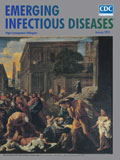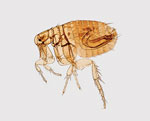
Volume 24, Number 1—January 2018
Etymologia
Etymologia: Plague
On This Page

Figure 1. Digitally colorized scanning electron microscopic image of a flea. Fleas are known to carry a number of diseases that are transferable to humans through their bites, including plague, caused by the...

Figure 2. Plague warning signs posted in regions where plague has been discovered. In remote areas with little human habitation, the most appropriate action may be to post signs on the roads entering...
Plague (from the Latin plaga, “stroke” or “wound”) infections are believed to have been common since at least 3000 bce . Plague is caused by the ancestor of current Yersinia (named for Swiss bacteriologist Alexandre Yersin, who first isolated the bacterium) pestis strains (Figure 1). However, this ancestral Y. pestis lacked the critical Yersinia murine toxin (ymt) gene that enables vectorborne transmission. After acquiring this gene (sometime during 1600–950 bce ), which encodes a phospholipase D that protects the bacterium inside the flea gut, Y. pestisevolved the ability to cause pandemics of bubonic plague. The first recoded of these, the Justinian Plague, began in 541 ace and eventually killed more than 25 million persons (Figure 2).
References
- Alexandre Yersin BW. Etymologia: yersinia. Emerg Infect Dis. 2010;16:496. DOIPubMed
- Centers for Disease Control and Prevention. History of plague [cited 2017 Oct 19]. https://www.cdc.gov/plague/history/index.html.
- Rasmussen S, Allentoft ME, Nielsen K, Orlando L, Sikora M, Sjögren K-G, et al. Early divergent strains of Yersinia pestis in Eurasia 5,000 years ago.Cell. 2015;163:571–82. DOIPubMed






















.png)











No hay comentarios:
Publicar un comentario